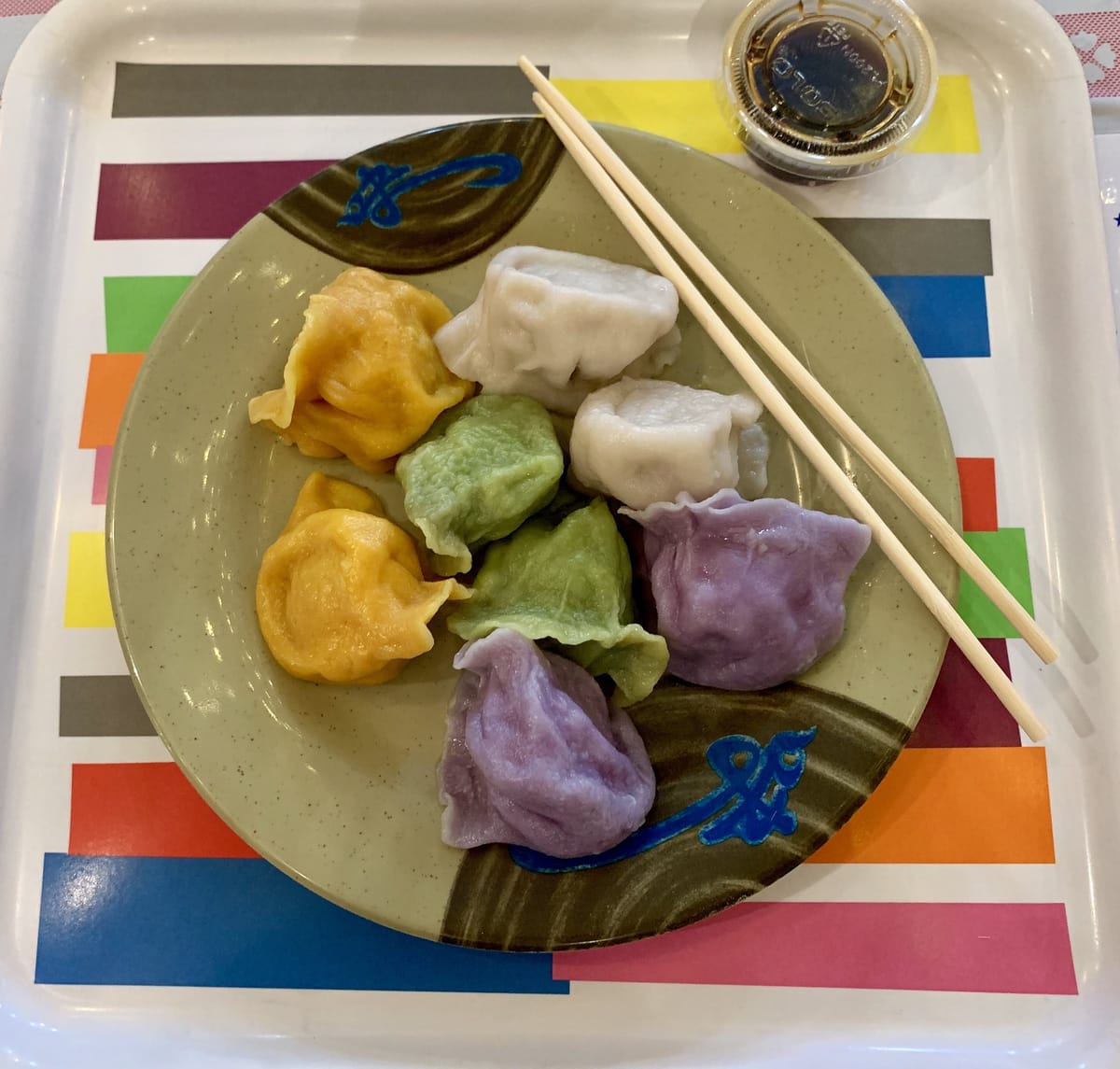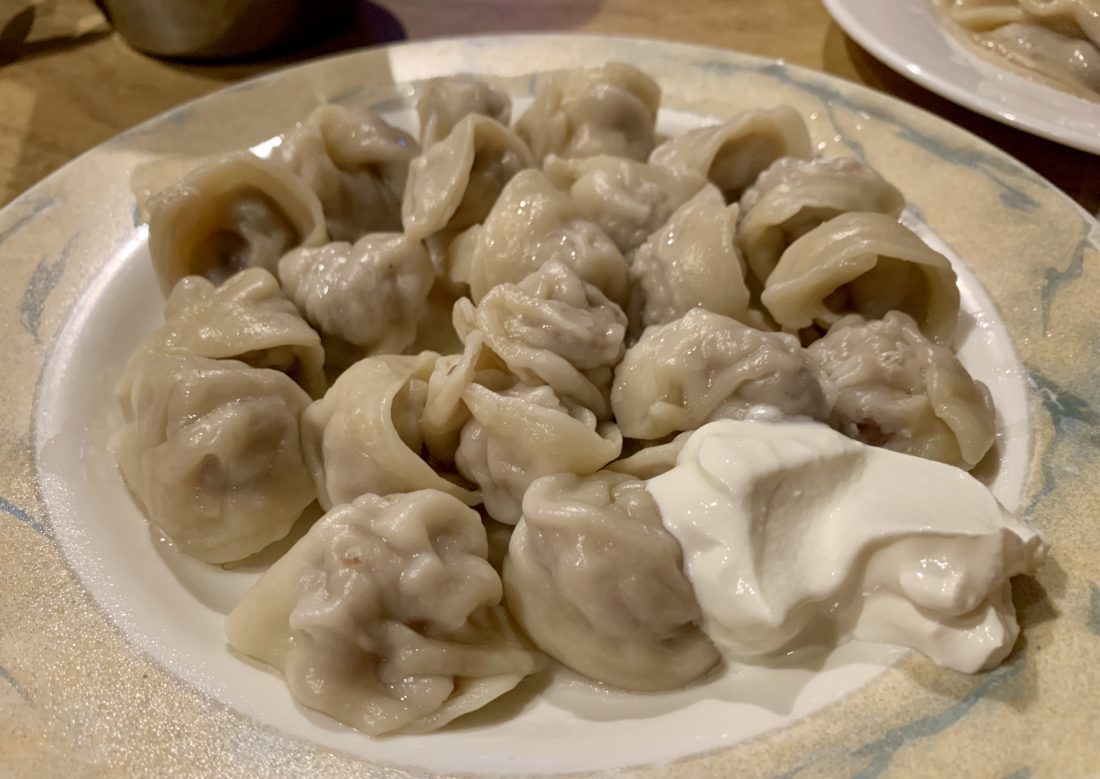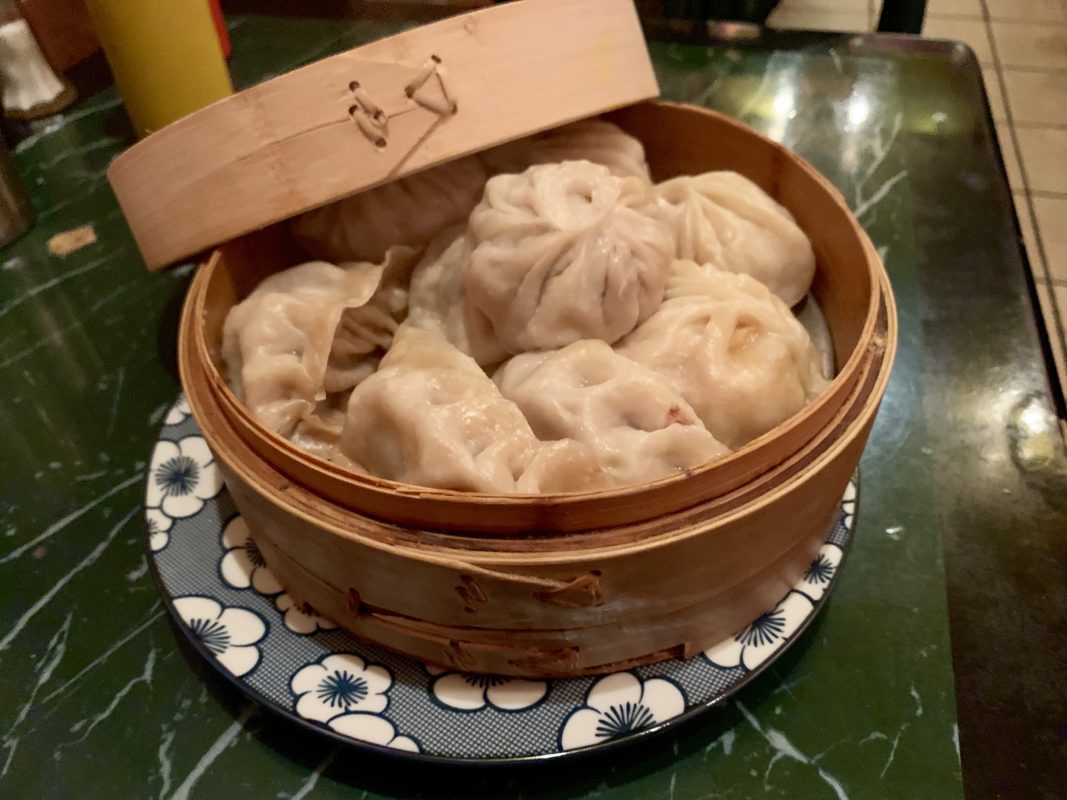Load Up On Dumplings at These Eight Brooklyn Spots

Brooklyn is a microcosm of the dumpling universe. Here, you can eat Tibetan momos, Georgian khinkali, and Cantonese har gow all in the same day, separated by little more than a train ride.
Writer Nick Kindelsperger wrote in an article for the Chicago Tribune that “dumplings are delightful things, born of thrift and culinary ingenuity, that can easily be eaten in a few bites.” That, he said, is the strictest definition he could reasonably assign to the word dumpling. ‘Dumpling,’ Kindelsperger writes, originally referred to nothing more than a lump of dough ‘dumped’ in liquid, as in the humble flour dumpling of the American south.
We’re not here to define what a dumpling is, either. We will tell you where to eat them, however. Here you have your pick of Polish, Georgian, Russian/Ukrainian, Uzbek/Uyghur, Tibetan, and Chinese spots. Times are tough, but dumplings will nearly always be nourishing, cheap, and plentiful.
Tone Café
Among the oozing loaves of khachapuri bread and bubbling stews at Tone Café, an old-school Georgian restaurant in Brighton Beach, sturdy, sack-like dumplings known as khinkali deserve their own spotlight. They come six to an order, filled with meaty broth and the option of pork, beef, or lamb.
Consuming the khinkali is almost ceremonious: the diner grabs the knobby handle of dough holding the whole thing together, drinks the broth, and nibbles away at the skin and heavily-spiced meat. The handles get tossed aside, piling up on each plate like a shameless tally of one’s appetite.

Tamara, who co-owns Tone Café with her husband, told us that the meat in their khinkali is primarily seasoned with a spice called dzira, which she couldn’t come up with any English translation for – a few Georgian recipe websites refer to it as ‘Georgian caraway.’ While khinkali originated in the mountains of eastern Georgia, Tamara said, they’re eaten all over the country, like in her home city of Kutaisi in the west. The process for making them is very complicated, she said, especially for creating the dumpling’s characteristic knot.
“I’m Georgian, but I cannot make it,” she said, laughing.
Varenichnaya
The wrinkly little pelmeni at Varenichnaya arrive heaped in the center of a wide plate, still glistening from their recent bath in boiling water, and appointed with a plush dollop of sour cream. The traditional “Siberian Meat Dumpling” option is simple and meat-forward: tender, yet still toothsome, dough gets wrapped around a gently seasoned ball of slightly gamy pork and veal, inviting a splash of dill, garlic, and peppercorn-infused vinegar from a glass bottle at each table. Diners can also choose plain veal or chicken fillings, and can even order them in broth – that’s the way Olga, who cooks at the restaurant with her parents, the owners, prefers to eat them.

There are also vareniki, the little half-moon pockets for which the restaurant is named. These come with a choice of savory fillings, like potato, or sweet, like cherry or cottage cheese. In the cherry variety, the dumplings burst with deep red fruit, and come tossed in sugar – not traditional, Olga says, but her American customers like them a bit sweeter.
Pelmeni and Vareniki can be found throughout much of the former Soviet Union, but Olga knows them from her home country of Uzbekistan, where her grandparents fled from the Ukraine during World War II. She suggests eating the dumplings simply with a bit of sour cream and vinegar, though she’ll hardly judge anyone who prefers them with housemade spicy tomato sauce. “I’ll give you some sour cream, and the rest is up to you,” she said.
Café Kashkar
The bulbous, thin-skinned manti at Café Kashkar, an iconic Uyghur Restaurant on Brighton Beach Avenue, are held together by tight pleats across the top, almost like a line of stitching. All the better to hold back a generous pocket of fatty, mildly seasoned ground lamb and chopped onion.

Cafe Kashkar is one of a small handful of New York restaurants serving the cuisine of Uyghurs, an oppressed Muslim minority group in China. Like New York’s other Uyghur restaurants, Kashkar’s menu is heavy with lamb as well as wheat-based bread and noodles. That extends to the manti, which are widely considered a Turkish dish, but are also eaten in varying forms across Central Asia, China, and in countries like Afghanistan. At Cafe Kashkar, the manti come with a small serving of sour cream: as with Varenichnaya’s pelmeni, the tang and coolness provides a counterbalance to the copious starch and protein. A similar option, the bready, thick-skinned “meat dumplings,” as they’re referred to on the menu, are round and pinched together on the top, reminiscent of a Chinese steamed bao.
Danik, whose family owns Cafe Kashkar, told us that the manti are filled simply with lamb, onion, and a bit of lamb fat. As with any good dumpling, they’re made by hand, and they’re much like what Danik’s family, who migrated to Uzbekistan from the western Chinese region of Xinjiang, would traditionally eat.
Bamboo Garden
Amidst the jumble of carts filled with steaming dim sum at Sunset Park’s Bamboo Garden, har gow is a dumpling worth seeking out.
Har gow is a staple of dim sum restaurants, and for good reason: the best ones are filled with plump, sweet shrimp, glowing pink from inside a thin, springy skin, which at Bamboo Garden is made from both wheat and potato starch. Live, locally-sourced shrimp arrive at the restaurant daily, said Andy Liao of Kings Corporation, the restaurant group behind Bamboo Garden. They’re tossed with salt and sugar, which makes the dumplings extra juicy.
Expertly prepared by a fleet of mostly Cantonese staff, many of which have decades of experience, the har gow are so delicate and well-seasoned that they need no sauce at all, Liao said — it would overpower the fillings.

You’ll need to brave the weekend’s madding crowds to feast on these beauties, but then you’ve got easy access to any number of the spot’s exemplary dumplings. One has an almost translucent skin, and is filled with a mixture of taro — a starchy purple vegetable — and pork. An unconventional variety of shumai — a squat, cylindrical dumpling — is wrapped with sticky rice instead of a regular dumpling wrapper, and filled with pork, shrimp, and taro. Point to them as they come around in carts, and a waiter will hand them to you in a bamboo steamer.
Kathy’s Dumplings
Some of Brooklyn’s prettiest dumplings come from Kathy’s Dumplings, a modest storefront on Third Avenue in Bay Ridge.

Here, the entire menu is prepared by a single cook named Xiaohong, who transforms chubby rounds of dough into dumpling wrappers with a deft hand and a tiny rolling pin. There is an original Kathy – Xiaohong’s sister — but she’s long since moved back to her Northeast China home, leaving the business to Xiaohong and her husband Tony, the shop’s owner.
One of the standouts at Kathy’s is the Number 12 — a combo called “Rainbow Dumplings.” A plate of eight dumplings arrives in four different colors – purple, green, orange, and the more typical white. The colors are vibrant, derived from purple cabbage, spinach, and carrots, and the flavors are subtle but noticeable: the carrot one has a pleasant earthy flavor. The green dumplings are filled with pork, shrimp and zucchini; the purple with pork, purple cabbage, and corn; and the orange with chicken, pork and carrot. The dumplings used to only come one color per order, but Tony chose to combine them.

“I think different color[s] together is beautiful,” he said.
The rainbow dumplings, Tony explained, are traditionally prepared during the Lunar New Year in parts of northern and eastern China, like his home city of Harbin. The ones there are also dyed naturally, with vegetables, and there’s no symbolism behind the colors, Tony said – they just make people happy.
Pierozek
At Pierozek, a Polish-owned shop in Greenpoint whose name means “little pierogi,” primarily local, Polish staff have been slinging over 2,000 pierogies a day since their opening in November.

The fresh pierogies come in seven different varieties, both savory and sweet — two bestsellers (and the owners’ favorites) have been the Ruskie pierogi, filled with cheese and potato, and the sauerkraut and mushroom ones. The shop caramelizes 50 pounds of onions per day, to top many of the pierogis.
Pierozek is a sister business to a shop called PierozeQ in Czestochow, the hometown of Radek Kucharski, who owns Pierozek with his wife, Alexandra Kucharski. Both grew up with pierogies: Alexandra, born into a Polish family in Greenpoint, was sent to Poland by her parents during summers, where she ate her grandmother’s homemade pierogies. Alex ate them at home, prepared mostly by the women in his family.
The menu was inspired by the original location, the owners of which actually sent two staff members over from Poland to teach staff how to make the dumplings properly. “We want to make sure every customer has the best pierogi possible,” Alexandra said.
Pierogies at Pierozek also come stuffed with meat, fruit (like fresh strawberries), or with sweet cheese. Mini pierogi, known as ushki, or “little ears”, come with traditional Polish borscht, or beet soup. Six older ladies produce all the food by hand, starting at 7am each day.
East Wind Snack Shop
The dry-aged beef potstickers at East Wind Snack Shop are almost obscenely juicy. The beef flavor is robust, like in a great hamburger, and just as tender — but hamburgers don’t come with a lattice-thin crust, shattering like the lid on a creme brulee.
The beef is from famed New York meat purveyor, Pat LaFrieda, said Chris Cheung, the shop’s co-owner and a veteran of several Michelin-starred New York restaurants. Beef is almost never used as a filling for dumplings in China, Cheung explained, but the technique was inspired by the wares of a dumpling stall in a village near Shanghai, where his wife is from, and where Cheung lived for a period of time. A local man would sear dumplings, handmade by his wife, in a lidded cast iron pan over a bamboo-fueled fire pit.
“They were sublime,” Cheung recalled.

While the beef dumplings have gotten the most attention from food media, Cheung said, the crescent-shaped pork dumplings are the bestseller and the “backbone” of the shop. “My whole thing, when I first opened the store, was I was chasing the perfect dumpling,” Cheung said.
The version he landed on consists of homemade skins stretched taut over an equally juicy, ginger-laced pork filling, which gets ground fresh.
There’s also an intensely flavorful vegetable dumplings, which come with an herb-based green sauce, and a shrimp har gow, bound by a lacy crust made of tapioca starch.
Café Tibet
Cafe Tibet, which seems to hover above the Q tracks at Cortelyou Station, is itself about as narrow and cramped as a subway car. No matter, though: the staff is as friendly as they come, and serve up bamboo steamers heaped with pudgy momos – Tibetan dumplings.
One of the waiters is a young woman named Mentok. She’s from Nepal, she told us, not Tibet, though she has Tibetan roots, and is well-versed in momo-making. “For me, it’s very easy,” she said. “For a new person, it’s very difficult.”

In the beef momos (Mentok’s favorite), the cooks add a masala, or spice blend, plus onions and garlic. There are also momos stuffed with vegetables, ones with pork, and ones with chicken. Different shapes denote different fillings — some are round, others more crescent-shaped. Missing, Mentok said, are the buffalo momo eaten in Tibet, and the yak ones eaten in Nepal. Still, the momos are much like the ones she ate growing up, steaming them for dinner and then frying off leftovers in the morning for breakfast.
The momos are sparsely seasoned, but the restaurant offers two kinds of thick, pureed hot sauce for dipping — one hot, the other mild. Mentok, however, said that there are much hotter ones. “If I make Tibetan sauce, you guys cannot eat,” she said, smiling.
Locations:
Tone Cafe – 265 Neptune Avenue, between Brighton 5th and Brighton 6th Streets in Brighton Beach
Varenichnaya – 3086 Brighton 2nd Street, near Brighton Beach Avenue in Brighton Beach
Cafe Kashkar – 1141 Brighton Beach Ave, between Brighton 14th and Brighton 15th Streets in Brighton Beach
Bamboo Garden – 6409 8th Avenue, between 64th and 65th Street in Sunset Park
Kathy’s Dumplings – 7924 3rd Avenue, between 80th and 79th Streets in Bay Ridge
Pierozek – 592 Manhattan Avenue, between Driggs and Nassau Avenues
East Wind Snack Shop
Windsor Terrace location – 471 16th Street, near Prospect Park West
Williamsburg location – inside of North 3rd Street Market, 103 North 3rd Street
Carroll Gardens – 253 Smith Street, between Douglass and Degraw Streets
Also inside of the Barclays Center
Cafe Tibet – 1510 Cortelyou Rd, next to Cortelyou Road Station in Ditmas Park



